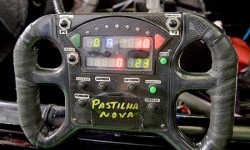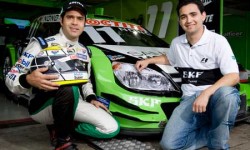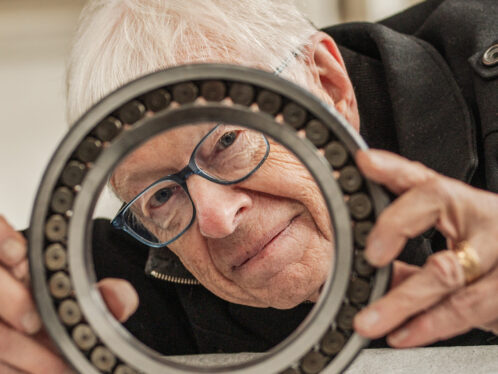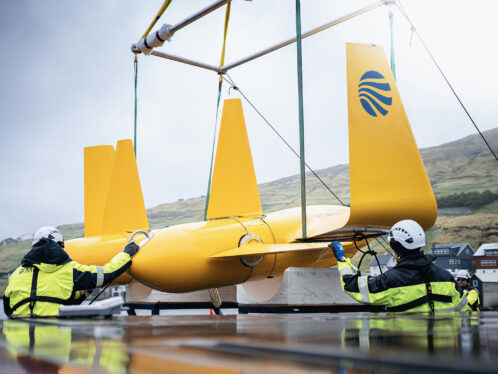
The race is on
Stock car racing has found fertile ground in Brazil, in 2009 generating 400 million Brazilian reais (178 million euros) in revenues and more than 35,000 spectators per race. A specifically designed wheel hub bearing unit from SKF is standard equipment on all participating cars.
Summary
Brazilian stock car racing
– First race – 22 April 1979
– Number of races per season – eight and a “Super Final” with 4 races
– Number of racetracks – 10
– Number of teams – 16
– Number of drivers – 32
– Total attendance 2009 – 425,000
– Average attendance per race 2009 – more than 35,000
– Revenues in 2009 – 400 million Brazilian reais (178 million euros)
– Jobs created – about 2,000
– 2009 champion – Cacá Bueno, Red Bull Racing.
Stock car racing has found fertile ground in Brazil, in 2009 generating 400 million Brazilian reais (178 million euros) in revenues and more than 35,000 spectators per race. A specifically designed wheel hub bearing unit from SKF is standard equipment on all participating cars.
he Brazilian stock car series traces its history back to 22 April 1979 and a race won by Affonso Giaffone at the Tarumã Speedway in the state of Rio Grande do Sul in southern Brazil. For the better part of two decades, the series operated at a semi-pro level, scraping for sponsorship and attention as Brazilian drivers Emerson Fittipaldi, Nelson Piquet and Ayrton Senna rose to international fame in the Formula One car racing and, in Fittipaldi’s case, the IndyCar series as well. Through most of the early years, racers drove a souped-up version of the Opala, a mid-sized Chevrolet that General Motors used to sell in Brazil.
By 2000, it became a case of “professionalize or die”, says Brazilian race driver Nonô se bild ueiredo. “The stock car series was born again.”
The first decadeof the 21st century brought one upgrade after another, on both the business and racing fronts. The sports promotion company Vicar Promoções Desportivas was brought in to operate the series under the oversight of the Brazilian Auto Racing Confederation. “The stock car series tries to mirror NASCAR,” says se bild ueiredo, referring to the wildly
popular and lucrative series in the United States. “But NASCAR has been around for over 50 years, and the Brazilian stock car series in its second phase for only 12 years. It’ll take a while, but we’ll get there.”
Already the numbersare impressive. In 2009, Brazilian stock car racing generated an estimated 400 million Brazilian reais (178 million euros) in revenues. In addition to individual backing for the 16 teams and 32 drivers, the series boasts a master sponsorship from telecommunications company Nextel that provides the official name for the elite category: the Nextel Stock Car Cup. Heavyweight help also came from Goodyear, Caixa Econômica Federal (a publicly owned savings bank), Esso, Medley, Bosch, Chevrolet and Peugeot, and drivers battled over 4 million reais (1.8 million euros) in prize money, divided amongst the Nextel Cup and three lower categories.
Television contracts,first with the Bandeirantes network and then with the dominant Globo network, have brought increased visibility. Race attendance jumped by more than 50 percent in five years, topping 35,000 on average per race in 2009. Predictably, the series has proven especially effective in drawing the prized demographic of upper- and middle-class men between the ages of 18 and 49. In 2010, Brazilian stock car racing is set to truly reach prime time. Heartthrob Marcello Anthony will play a stock car driver in Globo’s flagship 8 p.m. nightly telenovela. The series, Passione, started in spring 2010.
“It is the principal series in South America,” notes Carlo Vendramini Dessimoni, SKF’s director of automotive sales. “And it is growing in Brazil. It has a bright future.”
In large part, that bright future has been made pos-sible by a specially designed vehicle that maximizes performance while recognizing the financial constraints of a growing sport in an emerging country. By 2000, Zequinha Giaffone, younger brother of Affonso, the victor of Brazil’s first stock car race, had given up on a career as a driver and was running a kart-manufacturing business, when he received an offer from stock car officials to develop a world-class Brazilian vehicle from scratch. The first model was based on a blueprint that the officials had already purchased from Argentinean designers. But having a plan was just a start. “When you get right down to it, the challenge in Brazil, with limited financial resources, is to produce a car with the best possible technology at an acceptable price,” says Zeca Giaffone, director of JL Racing Products.
This translates intoadapting parts, a practice known in Brazil as “tropicalization”, from varied sources and jury-rigging them together in a way that approaches inter national standards for performance. By Giaffone’s estimate, his Brazilian designed and built stock car rings in at about a tenth of the price of a similar vehicle running in the DTM (Deutsche Tourenwagen Masters) series. “The price you pay is that the car is a little heavier,” he says. “But for the public these 100 extra kilos don’t make that much difference. And to trim those 100 kilos off would cost a lot of money.”
Giaffone works with more than 50 different parts suppliers, many of them outside Brazil. Often the best solution is to adapt a part from a top-end passenger car. Indeed, that’s how SKF’s wheel hub bearing unit made it into the mix. Giaffone liked the bearing unit that SKF Racing supplies to Ferrari for its GT3 cars, but that would have broken his budget. So, instead, SKF engineers worked with his team to adapt the bearing unit used by another high-quality car brand. “We had to work closely with SKF, just as we did with other suppliers,” says Giaffone. The SKF wheel hub bearing unit became standard equipment, starting with the 2009 season, and is used on all 32 vehicles in the 12-stage annual Brazilian stock car series.
The 2010Brazilian stock car series features a more powerful engine, which notably will run on ethanol fuel supplied by Esso. The biofuels initiative represents part of a larger plan to make the series environmentally responsible. In 2009 it began planting trees to offset the carbon emissions produced by the races and surrounding activities. “This is the kind of thing that is in line with SKF’s philosophy,” says Dessimoni, “to offer not only quality but to keep pace in terms of sustainability.”
SKF and Brazilian stock car racing
In Brazil, in the São Paulo suburb of Barueri, Goodyear and SKF are neighbours, and it was through contacts at the tyre manufacturer that SKF executives first met Brazilian race driver Nonô se bild ueiredo. Following the lead of SKF’s automobile racing sponsorships in Europe and the United States, the Brazilian subsidiary began to back the driver in 2004.
“Nonô carries our brand with him,” says Eduardo Mendes de Oliveira, automotive sales manager for SKF do Brasil, noting that the supplier relationship offers a “technical laboratory” for in-house engineers. Adds Carlo Vendramini Dessimoni, SKF’s director of automotive sales: “The stock car series highlights factors such as durability and advanced technology as well as the importance of being on the cutting edge.”
From se bild ueiredo’s point of view, the relationship extends well beyond mere financial backing. “SKF gives me credibility that differentiates me from other drivers,” he says. “It opens lots of doors.”
In 2007, a door opened for SKF to help produce a custom solution for the wheel hub bearing unit for Brazilian stock cars. To reduce the cost in relation to the part supplied to Ferrari in the GT3 series while maintaining the best possible performance, SKF engineers worked with their counterparts at Brazil’s JL Racing Products to adapt the bearing unit used by another high quality car brand. The result, mounted in stock cars in 2009, offers faster service, higher stiffness, less friction and reduced system mass. “There is less fuel consumption with less friction,” says Dessimoni. “This is technology that contributes to the environment.”
It comes through on the performance side as well, se bild ueiredo notes. “As far as I’m concerned, the wheel bearings are what define the performance of the car,” he says. “And,” he says, “racing is pure performance.”










